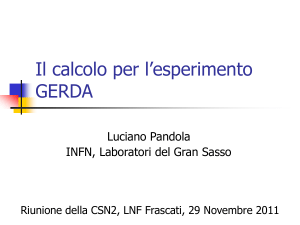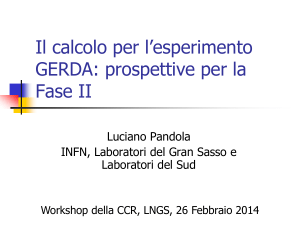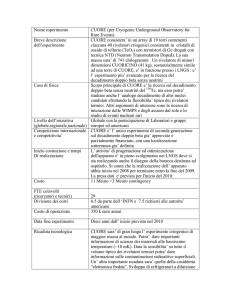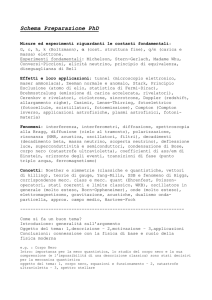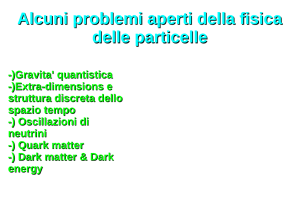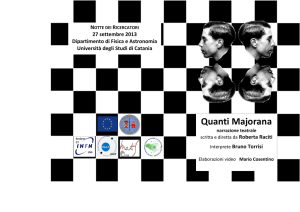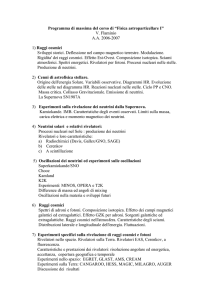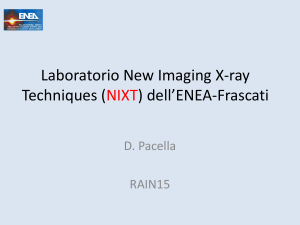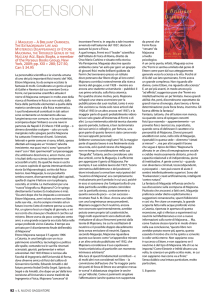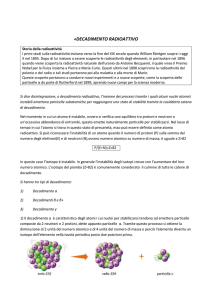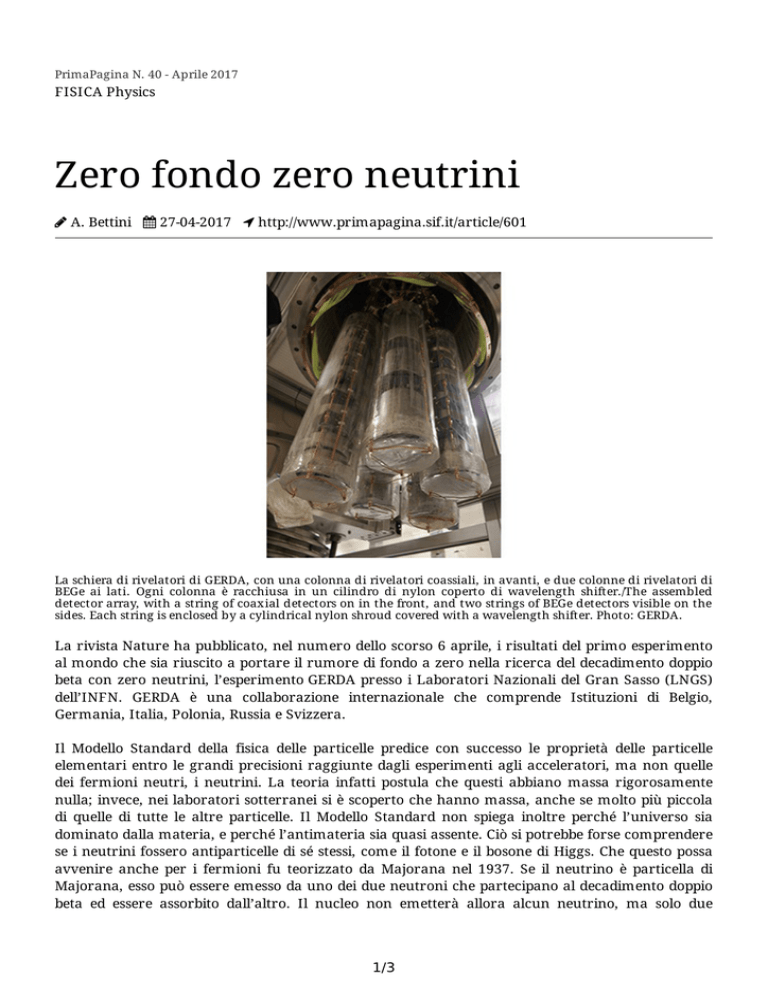
PrimaPagina N. 40 - Aprile 2017
FISICA Physics
Zero fondo zero neutrini
A. Bettini 27-04-2017 http://www.primapagina.sif.it/article/601
La schiera di rivelatori di GERDA, con una colonna di rivelatori coassiali, in avanti, e due colonne di rivelatori di
BEGe ai lati. Ogni colonna è racchiusa in un cilindro di nylon coperto di wavelength shifter./The assembled
detector array, with a string of coaxial detectors on in the front, and two strings of BEGe detectors visible on the
sides. Each string is enclosed by a cylindrical nylon shroud covered with a wavelength shifter. Photo: GERDA.
La rivista Nature ha pubblicato, nel numero dello scorso 6 aprile, i risultati del primo esperimento
al mondo che sia riuscito a portare il rumore di fondo a zero nella ricerca del decadimento doppio
beta con zero neutrini, l’esperimento GERDA presso i Laboratori Nazionali del Gran Sasso (LNGS)
dell’INFN. GERDA è una collaborazione internazionale che comprende Istituzioni di Belgio,
Germania, Italia, Polonia, Russia e Svizzera.
Il Modello Standard della fisica delle particelle predice con successo le proprietà delle particelle
elementari entro le grandi precisioni raggiunte dagli esperimenti agli acceleratori, ma non quelle
dei fermioni neutri, i neutrini. La teoria infatti postula che questi abbiano massa rigorosamente
nulla; invece, nei laboratori sotterranei si è scoperto che hanno massa, anche se molto più piccola
di quelle di tutte le altre particelle. Il Modello Standard non spiega inoltre perché l’universo sia
dominato dalla materia, e perché l’antimateria sia quasi assente. Ciò si potrebbe forse comprendere
se i neutrini fossero antiparticelle di sé stessi, come il fotone e il bosone di Higgs. Che questo possa
avvenire anche per i fermioni fu teorizzato da Majorana nel 1937. Se il neutrino è particella di
Majorana, esso può essere emesso da uno dei due neutroni che partecipano al decadimento doppio
beta ed essere assorbito dall’altro. Il nucleo non emetterà allora alcun neutrino, ma solo due
1/3
elettroni. La somma delle energie di questi due elettroni ha quindi un valore ben definito, pari al Q
valore del decadimento.
Per cercare questo decadimento, che, se esiste, è estremamente raro, si usano materiali che sono al
tempo stesso sorgenti del decadimento e rivelatori degli elettroni. La misura della somma delle loro
energie, con la massima risoluzione possibile, è, assieme al “rumore di fondo”, l’elemento cruciale.
Infatti si sa esattamente, entro una frazione di keV, dove cercare la “riga” nello spettro.
Esperimenti sono in corso nei laboratori sotterranei, dove il flusso della radiazione cosmica è
enormemente ridotto, ma ci sono altri fondi dovuti alle tracce di nuclidi radioattivi, che sono
presenti ovunque. La frontiera della ricerca è spostata in avanti dalla capacità di sopprimere il
rumore di fondo nella regione energetica di interesse. GERDA usa diodi di germanio (di due tipi
come mostrato in figura) immersi in argon liquido arricchiti nell’isotopo di interesse, il 76Ge. Questi
rivelatori danno la migliore risoluzione energetica esistente nel settore, pari circa 3 keV FWHM.
Nella sua “fase II” GERDA ha raggiunto il livello di fondo di progetto di circa un conteggio per
tonnellata per keV per anno di esposizione.
L’articolo pubblicato su Nature corrisponde ai dati raccolti nei primi cinque mesi della fase II. Non
avendo rivelato alcun evento nella regione di interesse, GERDA ha posto il limite sull’emivita di
5.3×1025 anni. GERDA raggiungerà la sensibilità di progetto di 1026 anni con un'esposizione di 100
kg anno e con 0.3 eventi di fondo aspettati in una finestra energetica di un FWHM. Diverse
modifiche per ridurre ulteriormente l’indice del fondo sono già allo studio nella collaborazione. Il
segnale potrebbe ben essere dietro l’angolo.
Scopri di più: 1, 2
Zero background zero neutrinos
On the 6th April issue of Nature results appeared from the first background-free experiment
worldwide in the search of double beta decay with zero neutrino emission, namely the GERDA
experiment in the INFN Gran Sasso Laboratories (LNGS). GERDA is an international collaboration
including Institutions from Belgium, Germany, Italy, Poland, Russia and Switzerland.
The Standard Model of particle physics successfully predicts the properties of elementary particles
within the high precision level of the experiments at the accelerators, but not those of the neutral
fermions, the neutrinos. Indeed, the theory postulates that these particles have rigorously zero
masses. On the contrary, experiments in underground laboratories have shown that they do have
masses, even if much smaller than those of the other particles. In addition, the Standard Model has
no explanation of the dominance of matter in the universe, and of being antimatter almost absent.
This might however be explained if neutrinos would be their own antiparticles, as the photon and
the Higgs boson are. That this can happen for the fermions too was theoretically shown by
Majorana in 1937. Now, if the neutrino is a Majorana particle, it can be emitted by one of the two
neutrons decaying in the double beta decay and be absorbed by the second one. The nucleus will not
emit any neutrino, but two electrons only. The sum of the electron energies has then a well-defined
value, equal to the Q value of the decay.
One searches for this decay, which, if it exists, is extremely rare, using materials that are sources of
2/3
the decay and detectors of the electrons at the same time. The measurement of the sum of their
energies with the best possible resolution is, together to the control of the “background noise”, one
of the two crucial elements. Indeed, we know exactly, within a fraction of a keV, were to search the
“line” in the spectrum. Experiments are being performed in the underground laboratories, where
the cosmic radiation flux is enormously reduced, but there are other background sources due to
the traces of radioactive nuclides that are present everywhere. Here the research frontier is pushed
forward by the ability to suppress the backgrounds in the energy region of interest. GERDA employs
germanium diodes (two types as shown in the figure) immersed in liquid argon, enriched of the
interesting isotope, the 76Ge. These detectors provide the best energy resolution of the field, of about
3 keV FWHM. In its “Phase II” GERDA has reached the design background index of about one
count per ton per keV per year of exposure.
The article in Nature corresponds to the data collected in the first five months of Phase II. Not
having detected any event in the region of interest, GERDA set a limit of 5.3×1025 years on the halflife. GERDA will reach the design sensitivity of 1026 years with an exposure of 100 kg yr and with
0.3 expected background events in one FWHM energy window. A number of improvements
suitable to further reduce the background index are being studied by the collaboration.
Learn more about: 1, 2
3/3

